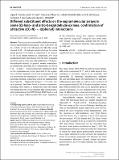Files in this item
Different substituent effects on the supramolecular arrays in some (E)-halo- and nitro-benzaldehyde oximes : confirmation of attractive π(C=N)···π(phenyl) interactions
Item metadata
| dc.contributor.author | Gomes, Ligia R. | |
| dc.contributor.author | Low, John N. | |
| dc.contributor.author | van Mourik, Tanja | |
| dc.contributor.author | Früchtl, Herbert | |
| dc.contributor.author | De Souza, Marcus V.n. | |
| dc.contributor.author | Da Costa, Cristiane F. | |
| dc.contributor.author | Wardell, James L. | |
| dc.date.accessioned | 2020-04-01T23:32:00Z | |
| dc.date.available | 2020-04-01T23:32:00Z | |
| dc.date.issued | 2019-04-24 | |
| dc.identifier | 258643828 | |
| dc.identifier | 0073a1d4-5d77-4d06-9792-4c9ba294c2e8 | |
| dc.identifier | 85064162861 | |
| dc.identifier | 000462978100002 | |
| dc.identifier.citation | Gomes , L R , Low , J N , van Mourik , T , Früchtl , H , De Souza , M V N , Da Costa , C F & Wardell , J L 2019 , ' Different substituent effects on the supramolecular arrays in some (E)-halo- and nitro-benzaldehyde oximes : confirmation of attractive π(C=N)···π(phenyl) interactions ' , Zeitschrift für Naturforschung B - A Journal of Chemical Sciences , vol. 74 , no. 4 , pp. 319-334 . https://doi.org/10.1515/znb-2018-0222 | en |
| dc.identifier.issn | 0932-0776 | |
| dc.identifier.other | crossref: 10.1515/znb-2018-0222 | |
| dc.identifier.other | ORCID: /0000-0001-7683-3293/work/57088456 | |
| dc.identifier.other | ORCID: /0000-0001-6647-4266/work/60887478 | |
| dc.identifier.uri | https://hdl.handle.net/10023/19743 | |
| dc.description | LRG thanks the Portuguese Foundation for Science and Technology (FCT) UID/Multi/04546/2013.for support. | en |
| dc.description.abstract | The crystal structures and Hirshfeld surface analyses are reported for four aldoximes, (E)-X–C6H4CH=N–OH [X = 3-Cl (1), 4-F (2), 2-O2N (3) and 4-O2N (4)]. The strong classical O–H · · · N hydrogen bonds involving the oxime group generate C(3) chains in compound 1, in contrast to the R22(6) dimers formed in compounds 2–4; such arrangements have been shown to be the most frequently found for oximes other than salicylaldoximes (2-hydroxybenzaldehyde oximes). In general, weaker intermolecular interactions involving the X substituents, as well as C–H · · · O and π · · · π interactions have significant effects on the supramolecular arrays generated in the aggegation. A further important interaction in compound 1, and to a lesser extent in compound 4, is a π(C=N) · · · π(phenyl) molecular stacking. A data base search has indicated that short Cg(C=N) · · · Cg(phenyl) distances, <3.3 Å (Cg = centre of gravity), have been found in various compounds, including other oximes. A theoretical study was carried out starting from the crystal structure data of compound 1, with optimisation at the BLYP-D3/def2-DZVP level, as well as at the higher PBE0/ma-def2-TZVP level. Breakdown of the interaction energy into separate contributions was achieved using SAPT (using the jun-cc-pvdz basis set). Overall, the calculations indicate that the π(C=N) ·· · π(phenyl) interaction is attractive, with a magnitude of 14–18 kJ mol−1. | |
| dc.format.extent | 2304920 | |
| dc.language.iso | eng | |
| dc.relation.ispartof | Zeitschrift für Naturforschung B - A Journal of Chemical Sciences | en |
| dc.subject | π(C=N)···π(phenyl) interactions | en |
| dc.subject | Aldoximes | en |
| dc.subject | Crystal structures | en |
| dc.subject | Quantum chemical calculations | en |
| dc.subject | QD Chemistry | en |
| dc.subject | DAS | en |
| dc.subject.lcc | QD | en |
| dc.title | Different substituent effects on the supramolecular arrays in some (E)-halo- and nitro-benzaldehyde oximes : confirmation of attractive π(C=N)···π(phenyl) interactions | en |
| dc.type | Journal article | en |
| dc.contributor.institution | University of St Andrews. Centre for Research into Equality, Diversity & Inclusion | en |
| dc.contributor.institution | University of St Andrews. EaSTCHEM | en |
| dc.contributor.institution | University of St Andrews. School of Chemistry | en |
| dc.identifier.doi | https://doi.org/10.1515/znb-2018-0222 | |
| dc.description.status | Peer reviewed | en |
| dc.date.embargoedUntil | 2020-04-02 |
This item appears in the following Collection(s)
Items in the St Andrews Research Repository are protected by copyright, with all rights reserved, unless otherwise indicated.

